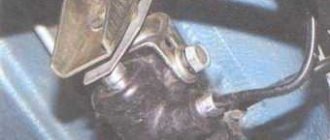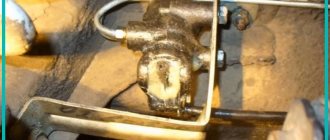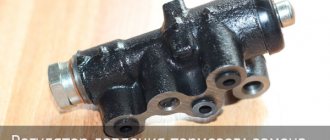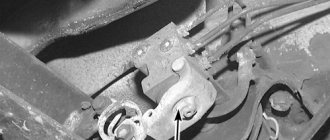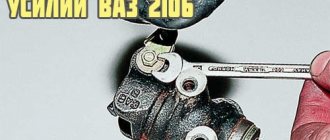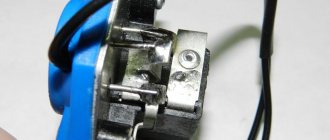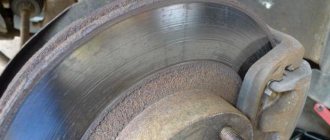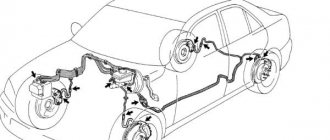A brake force regulator, or sorcerer in common parlance, is a mechanical device designed to relieve excess pressure in the rear drum brakes.
On VAZ-2109, VAZ-2108, VAZ-2114 and other front-wheel drive models produced in Togliatti, it was installed in the rear left part of the body, under the bottom, in front of the rear suspension beam. The brake pressure regulator on the VAZ-2107 model and other “classics” is located on the right in the direction of travel of the car.
New vehicles equipped with ABS and EBD do not use the sorcerer.
Why do you need a brake force regulator?
The function of the regulator is to temporarily reduce the braking force during heavy braking. The fact is that force evenly distributed on the rear and front axles can lead to a skid of the car. If the rear brakes start working a little later and weaker than the front ones, this does not happen.
Based on the above, we can conclude that the sorcerer is an element of the car’s safety system, partly preserving its stability on the road when the brake pedal is pressed in an emergency. On modern models, this function is performed by ABS. That is why there is no need today to use a technically outdated device in production.
Brake adjuster (sorcerer)
Have you ever seen “masters” regulating a sorcerer in the way described in the book? Usually several options are offered or all together:
- tighten the handbrake - replace the rear pistons - replace the sorcerer - replace the “worn out” rear brake pads - place a washer between the rod and the sorcerer plate, etc.
The principle of operation of the sorcerer is described in a smart book, I just want to say the following: the closer the plate is to the sorcerer rod (THE SMALLER THE CLEARANCE), the more “sensitive” the rear brakes are. The book indicates a gap of something like 2.1 mm, but this is ideal! Example: I have 1.0 mm.
The moment of actuation of the rear brakes at a certain pedal force depends on: 1. The sorcerer clearance
2. Positions of the sorcerer’s thrust (indirectly - the rear axle is unloaded/loaded, constantly - the ratio of the front and rear clearance, i.e. the difference between the height of the rubber profile and the height of the springs)
3. The gap between the pads and the drum (wear of the pads, “tightness” of the handbrake) Ideally, the gap in the sorcerer should be adjusted by changing even one of the parameters specified in paragraphs 2 and 3. But hardly anyone will do this. The sorcerer itself is adjusted only by changing the load on the rear axle (see paragraph 2). Therefore, after checking the operation of the brake system at the moment and tightening the handbrake, we adjust the gap.
By the way, how should the rear brakes work correctly: - if you have passengers or luggage behind you, then all wheels should brake almost simultaneously (the front ones a little faster) at any force on the brake pedal - this is good to check in the snow - if the rear axle is not loaded, then when you press the pedal lightly, only the front ones brake, and when you press it all the way down, all four brake. The most interesting thing here is the effort on the pedals at which the sorcerer begins to work. This is purely individual! Some people prefer instantaneous operation of the rear toms - then the gap in the sorcerer should be minimal or the sorcerer should be excluded from the system altogether (that's another story).
How does a sorcerer work?
The regulator itself consists of a cylinder, valve, spring and rod. The latter is connected to the rear beam, which ensures the operation of the VAZ-2109 sorcerer. Also, brake fluid circuits pass through the rear brake pressure regulator. For their mounting on the device there are 4 threaded entries. » alt=»»> How does the sorcerer regulator work on a VAZ? During emergency braking, the front of the car is pressed to the ground, and the rear is raised. This causes the regulator rod to move, which blocks the flow of fluid to the rear cylinders. A spring located under the valve prevents it from closing completely. Therefore, the rear mechanisms still work, but later and weaker than the front ones.
Adjusting the sorcerer VAZ 2114 - step-by-step instructions with photographs
From this article you will learn what a sorcerer is, why a car needs it in the braking system, what problems this unit encounters car owners, and you will also learn how to adjust the sorcerer on a VAZ 2114.
What is the sorcerer on the VAZ 2114 and where is it located?
This strange name “sorcerer” was given to car owners by the brake force regulator. This device first appeared in 1970. This is probably not accidental, because the behavior of a vehicle on the road depends on this mechanism: the length of the braking distance, whether the car will skid when turning and by how much. During braking, the load on the front and rear axles is distributed unevenly, therefore, in order to equalize the force between the axles for effective braking, dynamic correction of the braking process is required. This correction is performed by the brake force regulator. This small detail prevents the rear wheels from locking before the front wheels, and thereby prevents the car from skidding during braking. If the sorcerer is faulty or incorrectly adjusted, the machine may even overturn. The figure below shows the design of the brake regulator.
And below is its schematic image:
The brake torque regulator on the VAZ 2114 is located under the body at the rear, on the side of the left rear wheel, near the rear suspension beam. The VAZ-2107 and other “classic” models also have this mechanism, but it is located on the right side. New vehicles equipped with anti-lock braking devices and EBD electronic brake force distribution do not use the sorcerer. Understanding how the sorcerer works will help the car owner configure it correctly and operate it in the future. The sorcerer distributes the braking forces as follows: during sharp braking, the front is pressed to the bottom, and the rear is raised. In this case, the rod moves and thereby closes the flow of brake fluid to the rear brake cylinders. The spring holds the valve, preventing it from closing completely, so the rear wheel locking is activated, but a little later than the front ones. Ideally, the rear wheels should brake half a second after the front wheels.
How to adjust the sorcerer on a VAZ 2114?
Adjustment of the brake force regulator is required after each intervention in the car related to wheels, suspension elements and other work that changes the ground clearance. Any car owner will be able to adjust the sorcerer on a VAZ 2114 with his own hands, and, if necessary, replace it. To correct the work of the sorcerer, you need to drive into a pit or lift the vehicle on an overpass, because all the work will be done under the bottom of the car. To work, you will need a wrench (socket or socket) number 13. A screwdriver is needed to move the plate (5) and set the gap. A drill with a diameter of 2 mm or a washer of the same thickness will be required to adjust the gap. between the plate called the piston arm and the rear brake pressure adjuster to the correct size. A drill or washer will serve as a limiter so that when tightening the bolt (3) and locknut (4), you do not reduce this gap. After setting the required clearance, tighten the bolt and locknut, remove the drill (washer plate).
In this picture, the part of the sorcerer where the gap is set is enlarged. When the elements of the control unit become clogged with dirt and it becomes difficult to move the plate, use two screwdrivers, and use the bracket hole as a stop, as in this figure.
Please note that sometimes, due to dirt and souring, the piston lever sticks so much that it becomes impossible to move it, because the stuck bolts and nuts cannot be unscrewed. WD-40 will help clean these elements.
A car with a correctly adjusted sorcerer brakes smoothly, does not nosedive and does not skid to the side.
Replacing the sorcerer on a VAZ 2114
There are 3 signs that the brake torque regulator on the VAZ 2114 has become unusable and needs to be replaced:
- The cuffs are worn out and as a result, brake fluid leaks.
- When braking hard, the car skids heavily.
- The piston is soured.
Let me remind you that the manufacturer does not recommend changing the design of the brake force regulator or performing any manipulations with it. It is also not recommended to remove it from the car's brake system. By doing this, every car owner puts his life in danger. It is also recommended to replace a failed regulator and its subsequent adjustment at a car service center, entrusting this work to professionals. However, knowledge of how to replace the rear brake pressure regulator with a new one will not be superfluous for the car owner. So, you purchased a new regulator and went to the pit. First, remove the rubber plugs from the new regulator. Using a special 10mm wrench, disconnect the 4 brake pipes and immediately insert plugs into these pipes so that the brake fluid does not leak out. Unscrew the 2 mounting bolts on the bracket. In the figure above, these bolts are marked with the number 7. The bolts are unscrewed with the thirteenth key. We remove the old regulator and install a new one. First we connect the brake pipes, but do not tighten them yet. We adjust the gap to 2 mm. How to configure the VAZ 2114 sorcerer is also described above. Then tighten the brake pipes and pressure regulator mounting bolts. After the assembly is bolted, be sure to bleed the brakes and make sure there is no brake fluid leaking. If necessary, brake fluid should be added to the system.
Replacing the sorcerer with a tee
It is no secret that the reliability of the brake force regulator leaves much to be desired, causes many complaints from car owners, and many dream of getting rid of it. The most risky and confident drivers install a tee. You see him in the picture. This device is simpler than the sorcerer, less likely to leak. However, the distribution of braking forces does not occur, and the braking of the rear and front wheels occurs simultaneously.
Pros and cons of installing a tee
| Pros of installing a tee | Disadvantages of installing a tee |
| The brakes become more rigid and at the same time obedient | In winter conditions, the risk of skidding increases if the rear wheels are locked with brake pads before the front ones. |
| Service life increases | Braking becomes dangerous, especially in winter |
| The cost of a tee is less, the prices of a sorcerer | If the front hose ruptures, which happens quite often when a tee is installed, the brakes completely fail. Even the parking brake is a poor help in this case. |
You, of course, can use this scheme and “upgrade” the brake system in your car, but it will be much safer to monitor the condition of this system and, in particular, the sorcerer, and carry out preventive cleaning of this device more often. Then it will last longer.
There is an opinion that the tee is installed not instead of the sorcerer, but after it, and then this device will protect the force regulator.
Possible malfunctions of the sorcerer
The most common problem with the sorcerer is leakage of brake fluid from under the cuff, or at the junction with the brake pipes. It is impossible to eliminate leaks; you can only replace the entire assembly. The sorcerer is generally a reliable part and there are few malfunctions in it. Piston souring and valve jamming are two interrelated problems. They occur because the piston becomes clogged with dirt, which can be mixed with oils and other technical fluids. All this leads to undesirable consequences. In order for the sorcerer to last longer, it is necessary to periodically, at least once a season, drive the car into a pit and carry out general cleaning under the body, including cleaning the brake pressure regulator from dirt.
Possible malfunctions of the regulator
In general, there are few malfunctions that can occur in the sorcerer. These include:
- Valve jamming;
- Misalignment of position;
- Brake fluid leaks.
A deregulated sorcerer can be adjusted. You can determine the need for adjustment by the behavior of the car when you press the brake. If the regulator is set incorrectly, the car starts to toss to the side.
If the valve jams or fluid leaks, the mechanism must be replaced. Theoretically, it can be repaired. However, the process of such repairs is complex and expensive, which makes it unprofitable.
Setting the brake force regulator
Adjustment of the sorcerer should be done on an overpass or inspection hole. At the same time, the car is unloaded and driven to the work site. To perform the manipulation you will need:
- Socket wrench 13 or corresponding socket;
- Drill diameter 2 mm.
To adjust the sorcerer, use a wrench to loosen the bolt securing it to the lever bracket. Next, use a screwdriver to move the bracket until the resulting gap allows you to insert a prepared two-millimeter drill into it. After this, the bolt is tightened.
Note: the brake pressure regulator of the VAZ-2110 and previous VAZ models turns sour during operation so that it is not possible to move its bracket. In such a situation, you should pour WD-40 liquid over the rusted area, wait 15-30 minutes, and then use a hammer to move the part to the side using a soft drift.
Replacing the brake pressure regulator
The replacement of the sorcerer on VAZ-2110 cars and other vehicles equipped with an RTD is carried out on an overpass.
You need a 13 mm spanner, a powerful screwdriver and a special 10 mm wrench designed for unscrewing brake pipes. Before starting work, the assembly must be cleaned of dirt and rust, doused with WD-40 or another penetrating compound, and then wait half an hour. Related article: Main signs of a malfunctioning throttle sensor
Work begins by unscrewing the bolt securing the bracket to the spring. Afterwards, the brake pipes are dismantled, the position of which is recommended to be pre-marked.
Be sure to read
Do-it-yourself tube flaring
You can also unscrew the tube fittings with a regular wrench. However, using a special tool makes the job easier and reduces the likelihood of “licking” the edges. After the fittings, unscrew the two bolts securing the sorcerer to the body and remove the part.
It is necessary to install the new VAZ-2110 sorcerer in strict reverse order. After installing it and before adjusting the RTD, you should bleed the rear brake circuits. Next, the above-described procedure for setting up the sorcerer is performed.
Examination
The operation of the VAZ-2109, 2110 and other AvtoVAZ models is checked on the move, in closed areas. To do this, accelerate the car to a speed of 40 km/h and sharply press the brake. The rear wheels should lock 1/2 second later than the front wheels.
The wheels are monitored by an assistant located outside the car. If wheel locking occurs noticeably later or does not occur at all, and also if the rear axle is locked simultaneously with the front, the sorcerer adjustment procedure is repeated.
To increase the response time of the rear brakes, the gap between the adjuster and the bracket is increased; to shorten it, it is reduced accordingly.
HOW TO ADJUST THE WIZARD? HELP
Lada Kalina Hatchback 2011, petrol engine 1.6 l., 87 l. p., front drive, manual transmission — breakdown
Cars for sale
Lada Kalina, 2011
Lada Kalina, 2005
Lada Kalina, 2008
Lada Kalina, 2009
Comments 25
Consider installing an ABS system on your car so you don't have to deal with this.
It’s problematic to adjust it, and no matter how much I tried on the 2108 and 2110, one wheel always overbraked, and sometimes in the summer the butt kicked, but I’m generally silent about the winter! It was also necessary to add a little more clearance, tedious, but solvable. By the way, yes, for some reason one thing is over-braking
Which one is overbraking you?
Rear right. But it has stopped))) for now it works
what gap did you set? 2 mm or unscrewed two turns?
At first it was 2 mm, then I adjusted it several times, increasing it a little and decreasing it a little. You can't measure it exactly there later. Initially I measured with a drill
It’s clear, I just found three different options for adjusting this particular sorcerer, and it’s not clear which way to adjust. according to the book it is written that the gap should be checked between the sorcerer rod and the lever, on the Internet that between the bolt with a lock nut and the lever, and someone else found a way to set the distance from the lever to the body with a 14mm bolt... how did you adjust?)
Look there, when you press the brake, a rod comes out of the sorcerer, it presses on the pressure plate and together with it they go to the bolt that they rest against, I did 2 mm, pulled the spring-loaded bar with my fingers, and between the rod and the pressure plate it turns out
I did the same thing, inserted a 2mm plate between the sorcerer rod and the spring-loaded bar and twisted the bolt until it stopped, pulled it out and didn’t over-braking and seemed to slow down. Because it’s impossible to adjust between the 14mm plates, the spring doesn’t allow it to move
It’s clear, I just found three different options for adjusting this particular sorcerer, and it’s not clear which way to adjust. according to the book it is written that the gap should be checked between the sorcerer rod and the lever, on the Internet that between the bolt with a lock nut and the lever, and someone else found a way to set the distance from the lever to the body with a 14mm bolt... how did you adjust?)
In any case, you need a hole and try later, there is no other way.
We'll try to figure out what's what)
It was also necessary to add a little more clearance, tedious, but solvable. By the way, yes, for some reason one thing is over-braking
Because the sorcerer itself is not adjusted from the factory.
I removed the large nut, pulled out the spring and stretched it slightly (1-2 turns). I put everything back. Coludn began to work normally.
Yes, I just didn’t regulate it... So I sold it...
You tighten the bolt all the way, and then unscrew it 2 turns and tighten it. There was a 2mm gap on the old “sorcerers”. “Adjust the pressure regulator of the rear brakes of the VAZ Grant Kalina car, for which: - loosen the locking nut 4 and tighten the adjusting bolt 3 until it touches the lever 5 of the pressure regulator piston (wrench 10); 2 — unscrew the adjusting bolt 720° (2 cycles); — fixing the adjusting bolt in the specified location, tighten and tighten the locking nut. Nut tightening torque 6...7 N.m (0.6...0.7 kgf.m) (spanner 10, replaceable insert 10 type 58 23 10 10 f. "Stahlwille", torque wrench type 50 18 00 04 f. " Stahlwille")."
I think that’s what they did at the factory, so that I could then scratch my head and look for why it was over-braking)))
You tighten the bolt all the way, and then unscrew it 2 turns and tighten it. There was a 2mm gap on the old “sorcerers”. “Adjust the pressure regulator of the rear brakes of the VAZ Grant Kalina car, for which: - loosen the locking nut 4 and tighten the adjusting bolt 3 until it touches the lever 5 of the pressure regulator piston (wrench 10); 2 — unscrew the adjusting bolt 720° (2 cycles); — fixing the adjusting bolt in the specified location, tighten and tighten the locking nut. Nut tightening torque 6...7 N.m (0.6...0.7 kgf.m) (spanner 10, replaceable insert 10 type 58 23 10 10 f. "Stahlwille", torque wrench type 50 18 00 04 f. " Stahlwille")."
How does the brake force regulator - sorcerer - work?
What is the "Sorcerer" for? This is a rather mysterious detail and no one has found a clear answer to this question. Perhaps this is why he was colloquially called a “sorcerer”, because he works magically. At its core, this part performs a similar function to the anti-lock braking system, preventing the wheels of the rear axle from locking during emergency braking. Its operation directly depends on the position of the rear axle relative to the car body: when braking sharply, the car nose-dives, and the rear part of the body rises, after which the “witchcraft” begins - the brake force regulator partially blocks the flow of fluid, and the rear wheels do not lock.
Of course, in ideal conditions (dry asphalt, straight road, working brake system and chassis), the brake force regulator does its job perfectly. But such conditions do not always occur.
We adjust the sorcerer on VAZ 2108-VAZ 21099
Note! We recommend going to the article about the whereabouts of the sorcerer (as well as a lot of interesting things) “Brake pressure regulator and why does a car need it?”
1) At the very beginning of the operation, drive the car into the inspection hole and press on its rear so that the car’s suspension is in the middle position.
Note! It is recommended to make adjustments with the machine unloaded!
2) Next, using a 13mm wrench, loosen the bolt securing the regulator to the lever bracket.
3) Having loosened the bolt, insert a wire (drill) of suitable thickness into the gap located between the lever and the lever spring (the place where the wire is inserted into the gap is indicated by a red arrow). But for the wire to enter, at the same time move the bracket with a screwdriver until the wire enters the gap (the place where the bracket is moved with a screwdriver is indicated by a blue arrow).
Note! The thickness of the drill/wire is "2.0-2.1mm", otherwise the sorcerer will not be able to be adjusted normally.
4) And at the end, tighten the bolt securing the sorcerer to the bracket until it stops.
Note! After tightening the bolt, do not forget to remove the wire!
Examination:
The check is done after adjustment in order to understand whether it was possible to adjust it.
1) At the beginning, be sure to take an assistant, there is no other way.
2) Next, find a safe area, always level.
Note! We mean a place where there are no pedestrians, no cars, and no animals walking.
3) Ask an assistant to leave the car, accelerate to “40 km/h” and sharply press the brake pedal.
Device Description
The design and principle of operation of this element are quite simple. At the moment when the rear part of the car body rises and the distance between the axle and the body increases, a special lever is activated, which is connected in a “sorcerer”. This lever lowers the piston, which closes the brake fluid channel, and accordingly the pressure on the rear pads decreases. The wheels do not stop rotating and, accordingly, do not skid.
The idea itself is quite clever, but, as often happens, in practice it raises doubts. After all, if when braking the brake pedal is pressed with great force, then the front wheels go into skid and the car still begins to skid. Quite often, when observing a traffic accident, you will notice that the cars with the “sorcerer” are turned backwards. Is this related to this miracle detail, which in its essence should prevent this skidding?
Signs of a malfunctioning brake force regulator
“Sorcerer”, as an element of the braking system, has a number of signs of malfunction that manifest themselves during emergency braking. Let's look at the first symptoms that call for checking the regulator:
- When braking hard, the car pulls to the side.
- Reduced braking efficiency (feels).
- “Bouncing” and jerking of the car when braking.
In such cases, it is necessary to check not only the “sorcerer”, but also other components of the brake system and chassis. But, since we are talking about the brake force regulator on the VAZ, we will consider this particular mechanism. After placing the car on a lift, pay attention to the regulator. The most common sign of its malfunction is the presence of brake fluid leaks. In case of any malfunction, the best solution is to replace the sorcerer. But, if you still decide to repair the brake force regulator, then below we have prepared brief instructions for this action.
Sorcerer repair
In order to repair the brake force regulator, you need to perform a number of actions:
Thanks for subscribing!
- Dismantling. We remove the entire assembly, using wrenches 10 and 13. The brake pipes are unscrewed, the brake fluid is drained and plugs are installed in the pipes. Next, the “sorcerer” body is removed, which is attached to the bottom with two nuts.
- Diagnostics and replacement of “sorcerer” parts. Carefully examine the surface of the “Sorcerer”. If necessary, replace faulty parts (sealing rubber bands) using a repair kit. A soured piston cannot be repaired and requires a complete replacement of the unit.
- Installation of the sorcerer. Reassemble and adjust the part in reverse order and bleed the brake system. Add brake fluid.
Adjusting the braking forces of Lada Vesta
The operating principle of the system that regulates and distributes brake fluid pressure on Lada Vesta cars is fundamentally different from previous models, and there is no “witchcraft” in it. The Lada Vesta brake pressure regulator is directly connected to the ABS system and is electronically regulated depending on the speed of each wheel.
The ABS control unit transmits signals from speed sensors and analyzes the situation. The system “understands” any skidding and allows you to distribute the braking force with maximum efficiency. The pressure is controlled by the valves in the ABS hydraulic block, and there is no need for any magic. In addition, the electronics itself detects all malfunctions and reports them to the driver using a special lamp on the dashboard.
Many people have heard that there is a “sorcerer” in the braking systems of VAZ cars, but not everyone knows about the importance of this device. We evaluate its impact on braking efficiency.
“The sorcerer”, or, according to the catalogue, the pressure regulator in the brake drive, it was not for nothing that people received such an apt nickname: no one really knows how it works, but, they say, being faulty, it can present an unpleasant surprise - make the car dance in an emergency. braking. This is where the insidiousness of the “sorcerer” lies: during normal operation, without braking to the floor, its work or inaction is practically not felt, but when its help is especially needed, it may not come. The pistons have soured, the rod or drive lever has broken off, or you installed a new one instead of a faulty regulator, but for the time being you do not know that the unit is defective or misadjusted. How dangerous is this?
Let’s check in our experiment how “witchcraft” affects the effectiveness of the brakes at partial and full load of the Chevrolet Niva and Kalina and what the owner should be wary of if he does not monitor the condition of the regulator. We can simulate a malfunction, from excessive activity to complete inaction, with adjustments. Let us remind you that the regulator’s task is to reduce the braking force on the rear axle, reducing the likelihood of skidding when braking to skid. The regulator, mounted on the body and connected by an elastic lever to the axle beam, limits the pressure in the rear brake mechanisms depending on the position of the rear of the body relative to the road, that is, on the vehicle load.
checking and adjusting brakes on VAZ 2110 VAZ 2111 VAZ 2112 cars
Checking pipelines and connections To prevent sudden failure of the brake system of the VAZ 2110, VAZ 2111, VAZ 2112, carefully check the condition of all pipelines and connections, paying attention to the following: metal pipelines should not have nicks, scratches, burrs, active foci of corrosion and should be located away from from sharp edges that can damage them; brake hoses must not have any cracks on the outer shell or signs of chafing visible to the naked eye; they should not be exposed to mineral oils and lubricants that dissolve rubber; by pressing the brake pedal firmly, check to see if any swelling appears on the hoses, indicating their destruction; all pipeline fastening brackets must be intact and well secured; loosening or destruction of brackets leads to vibration of pipelines, causing their breakdowns; Do not allow fluid to leak from the connections of the master cylinder with the tank and pipelines; if necessary, replace the tank bushings and tighten the nuts without subjecting the pipelines to deformation. When tightening the pipeline nuts, use the wrench 67.7812.9525. Eliminate any detected faults by replacing damaged parts with new ones.
Flexible hoses, regardless of their condition, should be replaced with new ones after 125 thousand kilometers or after five years of operation of a VAZ 2110, VAZ 2111, VAZ 2112 to prevent sudden ruptures due to aging.
Checking the functionality of the vacuum booster VAZ 2110, VAZ 2111, VAZ 2112
Press the brake pedal 5-6 times with the engine off to create equal pressure close to atmospheric in cavities A and B (see Fig. 6-2). At the same time, by the force applied to the pedal, make sure that the valve body is not jammed. Keep the brake pedal depressed and start the engine. If the vacuum booster of the VAZ 2110, VAZ 2111, VAZ 2112 is in good working order, the brake pedal should “move forward” after starting the engine. If the brake pedal does not “go forward”, check the fastening of the hose tip, the condition and fastening of the tip flange in the booster, the hose to the tip and the fitting of the engine intake pipe, since loosening the fastening or their damage sharply reduces the vacuum in cavity A and the efficiency of the booster.
rice.
6-2. Vacuum booster: 1 - vacuum booster housing; 2 — amplifier housing cup; 3 - rod; 4 — adjusting bolt; 5 — rod seal; 6 — sealing ring of the main cylinder flange 7 — diaphragm return spring; 8 — amplifier pin; 9 — tip mounting flange; 10 - valve; 11 — hose tip; 12 - diaphragm; 13 — amplifier housing cover; 14 — sealing cover; 15 - piston; 16 — protective cover of the valve body; 17 — air filter; 18 — pusher; 19 — pusher return spring; 20 — valve spring; 21 - valve; 22 — valve body bushing; 23 — rod buffer; 24 — valve body; A - vacuum chamber; B - atmospheric chamber; C, D - channels Adjusting the brake drive of VAZ 2110, VAZ 2111, VAZ 2112
The free play of the brake pedal when the engine is not running should be 3-5 mm. The adjustment is carried out by moving the brake light switch 7 (Fig. 6-11) with nut 6 released. Install the switch so that its buffer rests against the pedal stop, and the free play of the pedal is 3-5 mm. In this position of the switch, tighten nut 6.
rice. 6-11. Brake drive: 1 — master cylinder; 2 - tank; 3 - vacuum booster; 4 — brake pedal bracket; 5 — brake light switch buffer; 6 — brake light mounting nut; 7 — brake light switch; 8 - brake pedal WARNING Adjust the free play of the brake pedal when the engine of the VAZ 2110, VAZ 2111, VAZ 2112 is not running. If the brake light switch is too close to the pedal, it does not return to its original position. In this case, valve 21 (see Fig. 6-2), pressing against body 24, separates cavities A and B, which opens air access to chamber B, and the wheels are incompletely released when the pedal is released.
If moving the brake light switch cannot eliminate the incomplete release of the brake mechanisms, then disconnect the brake master cylinder from the vacuum booster and check the protrusion of the adjusting bolt 4 relative to the mounting plane of the master cylinder flange (size 1.25-0.2 mm). This size can be set by holding the end of the rod with a special wrench, and with another wrench, tightening or unscrewing bolt 4.
"CHEVROLE-NIVA"
By the way, before testing tires on cars without ABS, each time we slightly adjust the regulator taking into account the road condition (snow, ice, asphalt), ensuring that the rear wheels lock a little later than the front ones. Let's not break tradition. Our Shniva found the gap between the cheeks of the regulator to be 16 mm, which was adjusted using a stop screw.
Several brakings, and the braking distance from 80 km/h for a car with a partial load is determined: 34.4 m. With a full load... 33.6! Almost a meter shorter! At the same time, the driver noted a heavier pedal and rapid heating of the brakes, which required cooling before each measurement. Let’s remember these parameters and make adjustments to the “sorcerer” adjustment. First, let's reduce the gap to 8 mm. Now the regulator significantly limits the pressure in the rear brakes, transferring almost all the hard work to the front ones.
Braking has become more difficult, keeping the front wheels from skidding is not so easy - they lock very sharply and the car, naturally, loses control. However, the result, to our surprise, is the same as in the basic version: 34.4 m. At full load, you have to press the pedal much harder, the front brakes begin to overheat. The result is 37.8 m. This is 4.2 m more than with the basic adjustment (33.6 m).
Checking and adjusting the free play of the brake pedal on VAZ 2108, 2109, 21099
The free play of the brake pedal of VAZ 2108, 21081, 21083, 2109, 21091, 21093, 21099 cars is 3-5 mm. In the braking system of VAZ 2108, 2109, 21099 cars, the free play of the brake pedal is the travel of the pedal from its top position until the brake mechanisms begin to operate. The upper position of the pedal is limited by the brake light switch (the pedal rests against its moving contact with its stop).
Checking the free play of the brake pedal of VAZ 2108, 2109, 21099 cars
We check the free play of the brake pedal with the engine turned off.
— We measure the distance from the floor to the released brake pedal
To do this, place a tape measure or ruler against the floor of the car and measure the distance to the upper surface of the platform with the pedal fully released.
— We measure the distance from the floor to the pressed brake pedal
Without removing the tape measure or ruler, lightly press the brake pedal with your hand and lower it down until you feel resistance to movement. Using a ruler or tape measure, we determine how many millimeters the pedal platform has dropped. This will be the free play of the brake pedal.
If it does not fit within the required limit of 3-5 mm (more or less than this value), we adjust the free play of the brake pedal.
Adjusting the free play of the brake pedal of VAZ 2108, 2109, 21099 cars
To adjust the free play of the brake pedal, you must move the rear brake light switch, which serves as a stop for the brake pedal. See photo at the beginning of the article.
— Loosen the locknut of the brake light switch
We use an open-end wrench at “19”.
— Move the brake light switch
To move, rotate the nut securing the brake light switch. We use the same key on “19”. To reduce the free play of the brake pedal, screw it (clockwise) onto the switch. To enlarge, on the contrary, turn it away (counterclockwise).
— Fix the brake light switch
Fix the switch in the required position by tightening the locknut.
— Check the free play of the pedal and the operation of the brake lights
After adjusting the brake pedal free play, check its value again. If it again does not correspond to the norm, we carry out the adjustment again.
In addition, we check that the brake lamps in the rear lights turn on in a timely manner. The switch must be in such a position in relation to the brake pedal that the brake lights turn on in a timely manner when it is pressed and do not burn with a constant light when it is released.
Notes and additions
— Why is free play of the brake pedal necessary on VAZ 2108, 2109, 21099 cars? It prevents spontaneous braking of the wheel brake mechanisms when the brake pedal is released.
"Chevrolet Niva"
The third state - we reduce the influence of the regulator by increasing the gap from the original one by 8 mm, that is, we set it to 24 mm. When there are two people in the car, the braking distance remains virtually unchanged - 34.3 m. However, now the rear wheels are blocked. But at full load the braking is very effective, the deceleration is easy to control and the result is a record: only 30.8 m!
In the normal position of the regulator, as the vehicle's weight increases, its braking distance decreases - this affects the more complete use of the traction weight by the rear wheels.
The best braking is at full load, when the regulator minimally limits the pressure in the rear brakes.
However, at partial load this can lead to skidding. The high center of gravity and short wheelbase of the Shnivy contribute to a significant redistribution of mass during braking, therefore, at partial load, the contribution of the rear axle to braking is small.
"LADA KALINA"
We set the regulator so that the rear is slightly late in locking the wheels. With this setting and partial load, the car needed only 27 m to stop. Fully loaded - 29.5 m. There are slight difficulties in preventing the front wheels from skidding. We reduce the gap in the regulator to zero - the half-empty Kalina stops after 31.8 m. The braking distance increases by 4.8 m, accompanied by a sharp blocking of the front wheels. The loaded one slows down after 35.2 m, the deterioration is even greater - 5.7 m! The pedal effort is increased and the brakes become noticeably hot.
Now we move the adjuster so that the rear brakes work as efficiently as possible. At partial load, the rear wheels suddenly lock and the car drifts off course—you have to release the pedal. On the verge of blocking it is very difficult to brake. The result is 30 m, which is 3 m worse than the “norm”. Full load gave a result of 26.9 m, which is 2.6 m better than the base (29.5 m). There are no comments regarding deceleration control. At the basic position of the regulator, the braking distance increases with increasing load. At partial load the spread of results is 4.8 m, so the base position is most effective. When you deviate from it in any direction, the braking distance increases.
On a fully loaded vehicle, depending on the position of the regulator, the spread of the braking distance is 8.3 m.
The best results, as on the Niva, come with increasing pressure in the rear brakes.
However, on a slippery road, even in smooth turns, early locking of the rear wheels is possible, leading to a skid.
And at partial load, with the regulator position different from the base one, the braking distance only increases.
How to regulate a new type of sorcerer on viburnum
I changed the regulator, installed a washer from an Opel injector 0.5 mm thick, but the fluid did not flow into the rear left brake cylinder. After I removed the washer completely, all four wheels began to brake. I adjusted it as expected - when braking from a speed of 40 -50 km/h, the front ones blocked, then the rear ones. But with a sharp deceleration from a speed of 70 km/h and above, it veered to the left. In the end, I switched the circuits to front-rear, rear circuit through one chamber of the regulator and now the brakes stop the car effectively and directly.
Added after 3 minutes The diagonal system could be adjusted if two single-chamber regulators were installed - one per circuit.
Added after 11 minutes Bus
, it is important that the rear not only begins to brake, but that the regulator gives the most equal forces to the rear wheels. Otherwise, one side will over-braking, since the GTZ provides equal forces to both circuits (at least it should).
| User menu kachukpv |
| View profile |
| Find more posts by kachukpv |
I continue my topic. In the summer, on good tires, on dry asphalt (with a gap in the sorcerer of 2.0 mm), the brakes are perfect without alteration of the sorcerer. Here is an example https://youtu.be/ToOZshJM4II
Added after 4 minutes But winter is coming (I remember that when braking I turned a little to the left). I began to bring the regulator (sorcerer) to an ideal state. Unscrewed the plug 15
and replaced the copper washer with a thinner one
Added after 9 minutes I checked what happened. I expected that the braking of the rear right (R.R.) would increase, but that was not the case, it DECREASED! I ground the washer even thinner - there is no effect, it over-brakes the rear left (Z.L.). Thought. I decided to bring the condition of the rear right brake mechanisms to perfection, although I understood that this was “catching fleas” Replaced the cylinder (it was a little “snotty”, but it worked) with an ATE Removed the risks on the drum and pads
I was about to give up on this diagonal system and switch to the axial one. I started studying hydraulic wiring. And..Eureka!
Added after 9 minutes I draw the attention of all owners of KALIN (not other front-wheel drive) - the hydraulic wiring from the sorcerer is done differently in 2110 and Kalina (from different holes) In view of this message from other related forums (2110, 14-15, priors), regarding the brake systems must be taken into account taking this feature into account! here's KALINA
but VAZ 2110 Thus, by changing the thickness of the copper washer, we change the braking force on the rear left (Z.L.) a thin washer - the braking force on the wheel is greater (the braking mark is larger) a thick washer - the braking force on the wheel is less (the braking mark is smaller) I installed 1.0 mm washer, I’ll test it until the weather gets wet
"Wizard" OR ABS?
And yet, such a regulator on a modern car is a legend of deep antiquity. It cannot compete with ABS, especially if the driver is an average driver who does not know extreme driving techniques. The curb weights of Kalina and Priora are almost the same - the difference is less than a percent. Using the same tires that were on the Kalina, the Priora with ABS showed the best results under any load. Moreover, no dosing of force on the brake pedal was required, you just press with all your heart, and the electronics do the rest.
Test results:
Test results
The optimal adjustment of the “sorcerer” corresponds to the average factory settings, and a few percent can be gained only with individual correction for specific brake pads, tires, vehicle loading and road conditions. But it’s unlikely that anyone will start every trip with a test run.
It would seem that it is possible to reduce the braking distance by increasing the pressure in the rear brakes, but this threatens a loss of stability due to early blocking of the rear wheels. And today only ABS can provide maximum braking efficiency.
On a fully loaded car, depending on the position of the regulator, the spread of the braking distance is 8.3 m. The best results, as on the Niva, are with increasing pressure in the rear brakes. However, on a slippery road, even in smooth turns, early locking of the rear wheels is possible, leading to a skid. And at partial load, with the regulator position different from the base one, the braking distance only increases.
